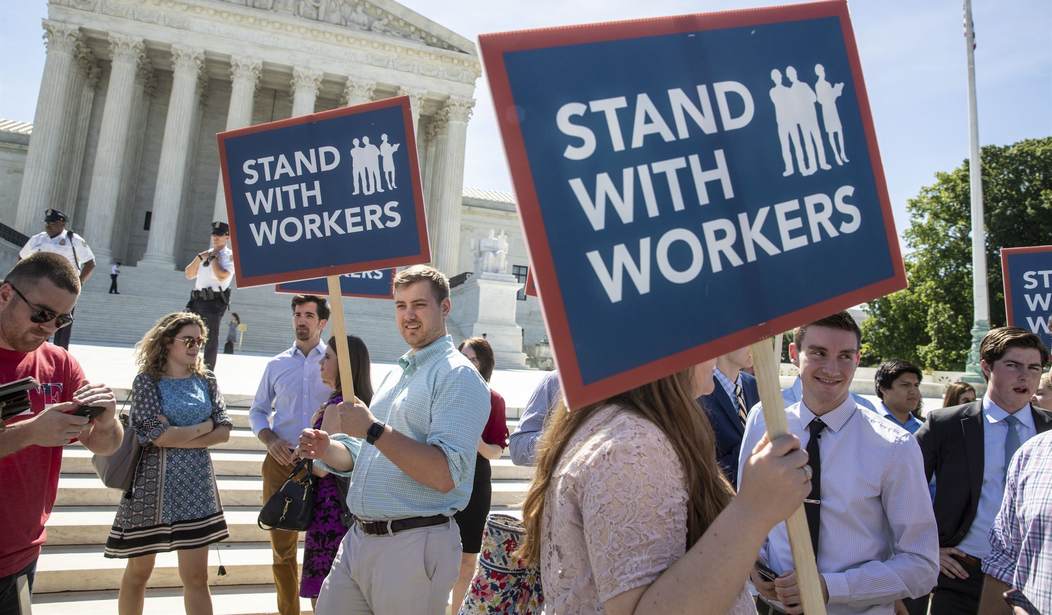Democrats and their allies claim that the Protecting the Right to Organize (PRO) Act will help workers, but a new study shows that the union bill will cost at least 2.7 million workers between $500 and $1,000 per year — and it will likely impose similar costs on up to 61 million workers in industries that could unionize under the bill. The bill will also threaten manufacturing jobs, which grow in states with right-to-work laws.
“Right-to-work laws ensure that American workers cannot be forced to pay union dues. These laws can save unionized workers between $500 and $1,000 a year. Since unions generally do not raise their members’ wages enough to offset the cost of compulsory dues, RTW laws can create meaningful savings for American workers,” reads the report, released by the Institute for the American Worker (IAW) on Monday.
“The PRO Act would abolish all RTW laws nationwide,” the report warns. Indeed, S. 420, the PRO Act, effectively strikes Section 14(b) of the National Labor Relations Act (NLRA), which allows states to implement right-to-work laws.
Recommended: Supreme Court Deals Severe Blow to Public Unions
By abolishing right-to-work laws, the PRO Act “would force at least 2.7 million American workers to pay union dues. Up to 61 million Americans in existing RTW states could be compelled to pay union dues if all of their workplaces were organized. Abolishing RTW would make America less attractive for investors and would thereby reduce job opportunities for Americans.”
Sen. Bernie Sanders (I-Vt.) claimed that the PRO Act would help “rebuild the middle class again,” but the report explains that “the PRO Act would cost workers heavily.”
Due to the landmark Supreme Court decision Janus v. AFSCME (2018), government employees cannot be fired for refusing to financially support the union that claims to represent them. The case involved Mark Janus, an Illinois child support staffer who refused to join the local union. The union forced him to pay agency fees, which went to promoting Hillary Clinton at the union’s 2016 convention.
The PRO Act would undermine workers’ ability to opt out of union membership and forced dues.
According to the IAW report, there were 2.7 million private sector employees in right-to-work states who are unionized under the NLRA. About one in six of these workers currently do not pay union dues, while the remainder pay dues voluntarily. If the PRO Act became law, all 2.7 million union-represented workers in right-to-work states would be forced to pay union dues or lose their jobs.
Workers voluntarily paying would lose the option to opt out if they later decided that the union stopped representing them effectively.
The 2.7 million workers includes 101,000 union-represented workers in Arizona, 136,000 in Georgia, 412,000 in Michigan, 89,000 in Virginia, and 125,000 in Wisconsin.
Another 61 million workers in right-to-work states have jobs in industries covered by the NLRA. Under the PRO Act, these workers may get forced to pay union dues if their workplaces get unionized. Currently, right-to-work laws protect these workers from being forced to pay union dues even if their workplaces unionize.
This 61 million includes 2.6 million workers in Arizona, 3.7 million workers in Georgia, 3.8 million workers in Michigan, 3.1 million workers in Virginia, and 2.3 million workers in Wisconsin.
IAW crunched the numbers in Arizona, Georgia, and Virginia, determining that the average annual cost of union dues in those states is $845.25, $804.95, and $554.65, respectively.
On the low end (taking the Virginia number for union dues), the PRO Act will cost the workers who choose not to pay dues in right-to-work states a whopping $249.6 million, while it may cost not-yet-unionized workers a staggering $33.8 billion. Considering the political affiliation of most unions, that represents a tremendous infusion of cash toward the Democratic Party.
Yet the PRO Act does not just represent a kind of tax on workers and a slush fund for the Left. According to the IAW report, it will also reduce workers’ job opportunities.
Right-to-work laws attract employers, especially in manufacturing. These laws attract investment and jobs. As David Brandon, senior vice president of the Site Selection Group, explained, “About 35-to-40 percent of manufacturing enterprises in the automotive industry insist on operating in a right-to-work state. Another 20-to-25 percent say it is a very important factor and will be used as a second- or third-tier factor in site selection. More than half of our companies either make it a threshold or a very important factor in making a decision on where to locate a factory and other operations.”
As Franklin & Marshall College professor Eunbi Kim explained in a 2019 paper, evidence from states that more recently adopted right-to-work laws reinforces this conclusion. Indiana (which adopted RTW in 2012), Michigan (2012), Wisconsin (2015), West Virginia (2016), and Kentucky (2017) “experience more growth in total manufacturing employment than non-RTW regions. In addition, foreign manufacturing employment also grows larger in new RTW regions than in non-RTW regions and to a greater extent than domestic manufacturing employment.”
Recommended: Workers Reject Unions, Costing Big Labor — and Democrats — $10 Million
The PRO Act, by eviscerating right-to-work laws, will raise the cost of doing business and cause employers to offer fewer jobs or to move elsewhere.
Democrats defend the PRO Act as a way to help workers and the middle class, but it will actually slap workers with dues and restrict job opportunities.









Join the conversation as a VIP Member